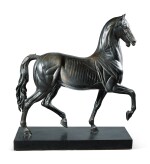The European Art Sale
The European Art Sale

After a model from the Circle of Giambologna (1529-1608) The Pastori Foundry Swiss, Geneva, 1984
Lot Closed
October 25, 02:42 PM GMT
Estimate
30,000 - 50,000 USD
Lot Details
Description
After a model from the Circle of Giambologna (1529-1608)
The Pastori Foundry
Swiss, Geneva, 1984
THE TORRIE HORSE
number 13 of a limited edition of 24 cast from TheTorrie Horse, Edinburgh University
numbered: 13/24 and stamped: (FONTE / MARIO PASTORI)
bronze, on a wood base
horse: 34⅝ by 34¼in; 88 by 87cm.
base: 2½ by 31½in; 6.5 by 80cm.
The horse is essentially an écorché of the beast from the equestrian statue of Marcus Aurelius on the Campidoglio. The model is believed to have been conceived in Giambologna's studio, possibly in preparation for the equestrian statue of Grand Duke Cosimo I de' Medici commissioned in 1587 and finished in 1594. It has been argued that the original would have been a wax, which may have been pigmented so as to better delineate the anatomy. Baldinucci records that Giambologna made studies of the horse in 1587 and that he was assisted at this time by Lodovico Carde, Il Cigoli, who was famed for his studies of cadavers (one of his waxes is in the Bargello). Evidence for the existence of the model in the 16th century is found in three plates which depict a near-identical flayed horse from Carlo Ruini's Dell Anatomia et dell infirmita dell Cavallo of 1598. It has been argued that Ruini's horse may derive from a lost wax progenitor of the Torrie Horse (Macmillan, op. cit., p. 14).
Three further casts of the model are recorded. One in the Palazzo Vecchio shares similarities in the casting with the Torrie Horse. Together they are generally assumed to be the earliest casts and may date to before 1707 when the Mattei Horse is first recorded (indeed, it cannot be discounted that one of them may be the Mattei bronze). A further cast acquired in Venice in 1900 is held in the Museum of Fine Arts, Springfield and is thought to date to the 18th century. A fourth, traditionally believed to come from the collection of the Dukes of Northumberland, has been attributed to Valadier and was sold at Christie's London on 4 July 2013, lot 10, for £1,405,875 (aggregate).
Of the casts from the Pastori edition, the first was acquired by the breeders' Cup World Championships and is held in their headquarters in Lexington, Kentucky. A reduction is given as the Breeder's Cup trophy. Mario Pastori was a member of the fifth generation of Italian founders and craftsmen of the highest quality, specialising in the lost wax technique, and casting works by sculptors including Alberto Giacometti and Henry Moore. The Torrie Horse was one of his last commissions. Casting a full scale replica of the Torrie Horse from one mould was such a technical feat that Pastori was to describe the experience as 'receiving my Field Marshal's Baton'. He died shortly afterwards.
RELATED LITERATURE
A. Radcliffe and C. Avery (eds.), Giambologna 1529-1608: Sculptor to the Medici, exh. cat. Arts Council of Great Britain, London and Edinburgh, 1978, pp. 185-186, no. 169;
J. Winter, Valadier: Three Generations of Roman Goldsmiths, London, 1991;
D. Macmillan, A Catalogue of the Torrie Collection, Edinburgh, 2004, pp. 13-15;
J. Warren, 'Giambologna in Inghilterra e in America' in B. Paolozzi Strozzi and D. Zikos (eds.), Giambologna gli dei, gli eroi, Museo Nazionale del Bargello, Florence, 2006, p. 134
